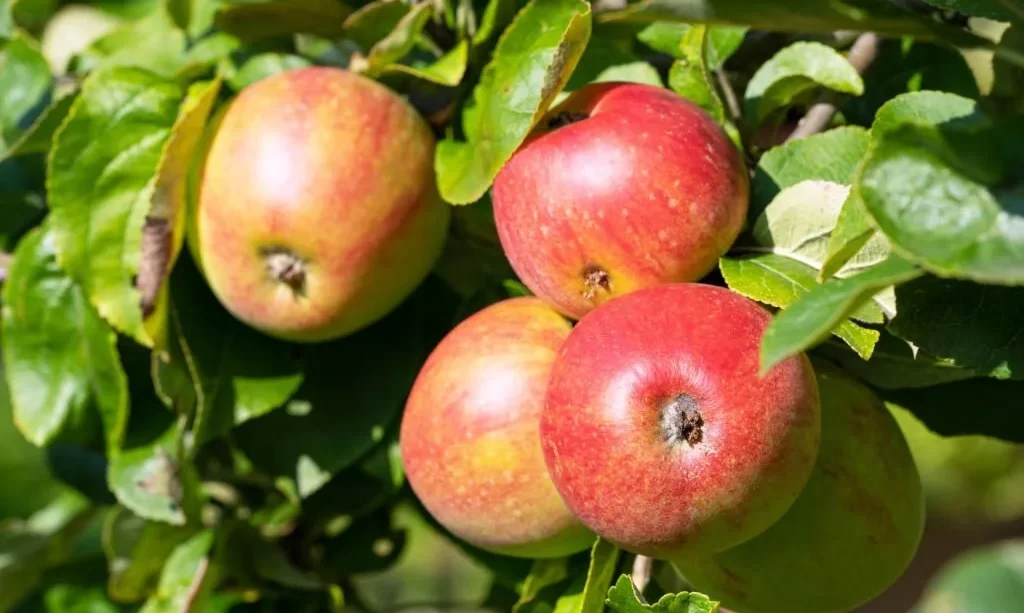Apple trees, with their iconic blossoms and sweet, crisp fruit, hold a cherished place in the world of horticulture. These fruit-bearing trees, scientifically known as Malus domestica, have graced gardens, orchards, and landscapes for centuries, captivating both seasoned gardeners and novices alike. Yet, as with any living organism, the thriving of apple trees depends on various factors, one of which is the availability of sunlight. The question that often arises among those who nurture these trees is: Do apple trees need full sun to flourish? In this exploration, we will delve into the world of apple trees, their unique characteristics, and the significance of sunlight in their growth and fruit-bearing journey.
- Introducing the Low-Chill Fuji Apple Tree, your gateway to an abundance of fresh, sweet apples right in your backyard. Perfect for those seeking a fruitful harvest in regions with milder winters, this tree delivers the iconic flavor and crispness of Fuji apples without the need for extensive winter chilling. With the Low-Chill Fuji, enjoy the delightful taste of this classic apple variety.
- Delivering Nature’s Joy: From large, high-impact trees and reliable, versatile shrubs to tropical fruits, rare house and patio plants and much more, our varieties provide the garden solutions you need
- Ready For Gardeners of All Levels: No matter where you’re at in your planting journey, what your yard looks like or what you’re dreaming it will look like, we’ve got you covered
- Brighten Your Home: Bring the joy of gardening straight to your home, one bloom at a time. Whether you’re looking for the perfect finishing touch or designing a whole new garden space, we hope our plants will bring you happiness for seasons to come!
- Shipping Restrictions: Due to Federal restrictions if you live in the following states, your order will be cancelled: AZ, CA, ID, OR, and WA
Apple Tree Overview
Before we embark on understanding the role of sunlight in the lives of apple trees, let’s take a moment to acquaint ourselves with these remarkable fruit-bearing trees:
Apple trees belong to the Rosaceae family, and their origins can be traced back to the rugged slopes of Central Asia. Over centuries, they have been cultivated and selectively bred to yield a staggering array of apple varieties, each with its distinct flavor, texture, and purpose. From the sweet, juicy Gala apple to the tart and versatile Granny Smith, apples come in an assortment of tastes and colors, making them a beloved staple in kitchens worldwide.
Beyond their culinary significance, apple trees are known for their aesthetic appeal. In spring, they burst into a profusion of delicate blossoms, painting orchards in shades of white and pink. These blossoms transform into the crisp, succulent apples that grace our tables in the fall. Whether planted as ornamental trees or nurtured in orchards for harvest, apple trees captivate our senses with their beauty and bounty.
Now that we have a foundational understanding of apple trees and their significance, we can explore the importance of sunlight in their growth and fruit production.
The Importance of Sunlight for Apple Trees
Sunlight is to apple trees what nourishment is to the soul. It plays a pivotal role in nearly every aspect of their growth and fruit-bearing journey. Here’s a closer look at why sunlight is essential for these magnificent trees:
- Photosynthesis: Sunlight is the energy source that fuels the process of photosynthesis. In the green leaves of apple trees, chlorophyll captures sunlight and uses it to convert carbon dioxide and water into sugars and carbohydrates. These sugars serve as the building blocks for the apple tree’s growth and the sweet fruit it produces.
- Fruit Development: Adequate sunlight is paramount for the development of high-quality fruit. The energy produced through photosynthesis not only fuels growth but also contributes to the sweetness, size, and color of apples. Sunlight helps fruit ripen uniformly and reach its full flavor potential.
- Disease Resistance: Sunlight aids in the prevention of diseases. It dries the foliage, reducing the moisture that can harbor fungal infections and pests. Proper air circulation facilitated by sunlight also helps prevent the buildup of humidity, which can encourage disease development.
Sunlight Requirements for Apple Trees
Apple trees thrive best when they bask in the warmth and brilliance of full sun. Here are the general sunlight requirements for healthy apple trees:
- Full Sun Exposure: Apple trees ideally require a minimum of 6-8 hours of direct sunlight each day. Full sun exposure allows them to carry out robust photosynthesis, resulting in vigorous growth and abundant fruit production.
- South-Facing Locations: If possible, choose planting locations that receive ample southern exposure. South-facing sites receive the most sunlight throughout the day, which is especially beneficial in regions with cooler climates.
- Due to California Department of Agriculture we CAN NOT ship this item to the state of California***
- 4-5ft tree in a 1 gallon pot
- Bearing fruit age
- Cannot Ship to HI or AK
Effects of Insufficient Sunlight
Insufficient sunlight can cast a shadow over the health and productivity of apple trees. Here are some of the potential effects of inadequate sunlight:
- Reduced Fruit Production: Apple trees in shaded or partially shaded areas may produce fewer fruits, and the fruits they do produce may be smaller in size and less flavorful.
- Sparse Foliage: Trees lacking sunlight may develop sparse foliage, limiting their capacity to capture energy through photosynthesis. This can result in weaker overall growth.
- Disease Susceptibility: Shaded conditions can create a moist and stagnant environment within the tree’s canopy, making it more susceptible to diseases like apple scab and fungal infections.
- Pest Attraction: Weakened trees may also be more appealing to pests like aphids and spider mites, further compromising their health.
Understanding the pivotal role of sunlight in apple tree health and fruit production underscores the importance of choosing the right location and providing optimal care to ensure these remarkable trees thrive in all their glory.
Selecting the Right Location
Choosing the right location for planting apple trees is a critical step in ensuring their access to the sunlight they require. Here’s what you should consider when selecting the ideal spot:
- Full Sun Exposure: Whenever possible, opt for a location that receives full sun for a significant portion of the day. This often means choosing a site with southern exposure, where the trees can bask in sunlight from morning until late afternoon.
- Spacing: Adequate spacing between apple trees is vital to prevent shading from neighboring trees. Ensure that there’s enough room for each tree’s canopy to fully extend without overlapping with others.
- Orientation: Consider the orientation of your planting area. Rows of apple trees are typically planted in a north-south direction to maximize sunlight exposure on both sides of the trees.
- Avoid Obstacles: Be mindful of obstacles such as buildings, walls, or large trees that could cast shadows on your apple trees. These can significantly reduce the amount of sunlight they receive.
Sunlight and Pruning
Pruning plays a crucial role in optimizing sunlight penetration within the canopy of apple trees:
- Thinning the Canopy: Regular pruning helps maintain an open and well-ventilated canopy, allowing sunlight to reach all parts of the tree. Remove crowded or crossing branches to improve light distribution.
- Removing Shade-Producing Growth: Identify and eliminate any water sprouts or excessive vertical growth that can create shade within the tree’s interior.
- Training Techniques: Utilize training techniques like espalier or central leader pruning to shape the tree in a way that maximizes sunlight exposure to the fruit-bearing branches.
Conclusion and Key Takeaways
In conclusion, sunlight is indeed the lifeblood of apple trees, powering their growth, fruit production, and overall health. For apple trees to flourish and yield bountiful harvests of delicious fruit, they require a minimum of 6-8 hours of direct sunlight per day, preferably in a location with full sun exposure.
Key takeaways from this exploration emphasize the importance of selecting the right location for planting apple trees, where they can enjoy abundant sunlight and avoiding obstacles that may cast shadows. Additionally, the role of pruning in enhancing sunlight penetration within the tree’s canopy should not be underestimated.
By prioritizing sunlight, gardeners and orchardists can ensure that their apple trees thrive, rewarding them with a bounty of crisp and flavorful apples season after season. Remember that a sun-drenched apple tree not only graces the garden with beauty but also offers the sweet promise of a fruitful harvest.






